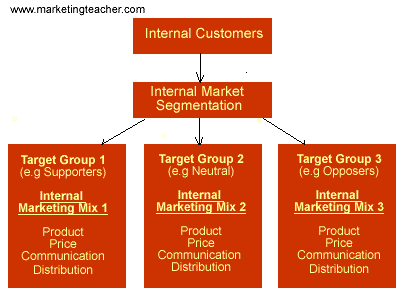Strategic Internal Marketing
Internal marketing is an important ‘implementation’ tool. It aids communication and helps us to overcome any resistance to change. It informs, and involves all staff in new initiatives and strategies. It is simple to construct, especially if you are familiar with traditional principles of marketing.
See also Internal Marketing
Let’s have a look a closer look at the practicalities of internal marketing.

At this stage internal marketing meets traditional ‘change management.’ Firstly you should identify your internal customers. As with your external customers, they will have their own buyer behavior/behaviour, or way of ‘buying into’ the changes which you are charged to implement. The similarities in differing groups of internal customers allows you to segment them. As Jobber (2009) explains, you can target three different segments namely ‘supporters,’ neutral,’ and finally ‘opposers.’ Each group requires a slightly different internal marketing mix in order that your internal marketing objectives can be achieved.
For example, if the change was that a company was to relocate closer to its market, you could target ‘supporters’ with a tailor-made relocation video explaining about the lower property prices in the new location; ‘neutral’ internal customers could be targeted with incentives such as pay increases; and ‘opposers’ could be coerced, or forced to accept the change regardless.
How do we plan for a change program?
- Always make sure that you have thought through your approach before starting the implementation.
- Make sure that you have created a cultural climate that is willing to accept change.
- Appoint a change agent, or champion for change that will help to ease your changes through.
- Audit the skills and capabilities of your team. Train and develop as necessary.
- Your team must be built around you with the objective as the focus for you all.
- The change must be correctly marketed to your target audience using an approach such as Jobber’s (above).
- Decide what the change will be. Give it boundaries.
- Decide upon the plan.
- Work out a realistic budget and stick to it.
- Try to anticipate the arguments against change, and decide how to counteract them positively.
If not, it would be valuable to spend some time considering marketing plans. Internal marketing obeys the same rules as, and has a similar structure to, external marketing. The main differences are that your customers are staff and colleagues from your own organization.

Managing the implementation of internal marketing (Jobber 2009)
In previous lessons, you will have seen that the process of marketing follows a familiar pattern for which we use the acronym AOSTC – Analysis, Objectives, Strategies, Tactics, and Control. In the diagram above, Jobber (2009) uses a similar approach as a structure for the implementation of internal marketing. The process is straightforward.
- Set objectives for internal marketing e.g. to persuade 100 staff to join a new Performance Related Pay (PRP) scheme.
- Your strategy is ‘internal marketing.’
- Tactics would include an internal application of the marketing mix, and could include staff forums, presentations, an intranet, away days, videos, personal visits by company directors or newsletters.
- Evaluation would consider the take up of PRP against your objectives, attendees at away days, visits to an intranet page, and so on.
